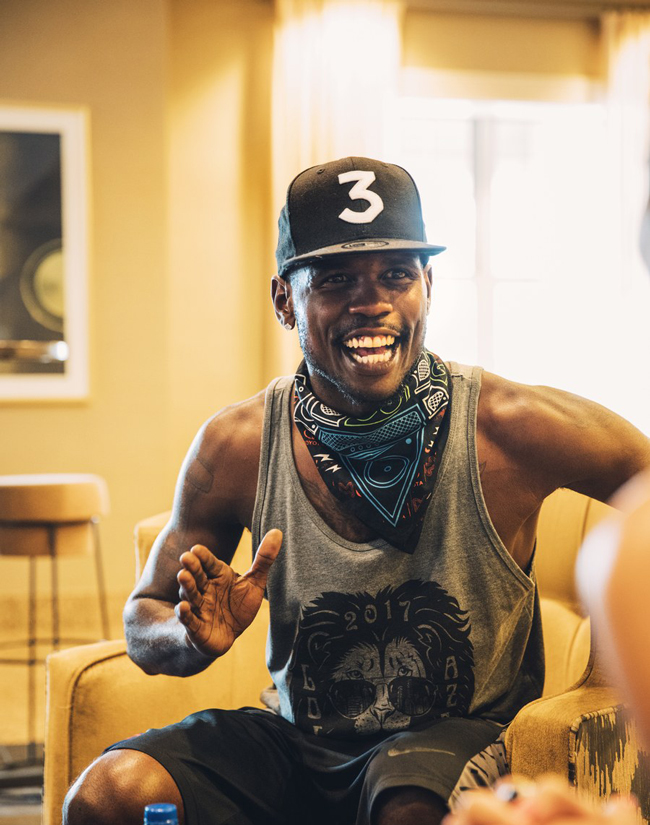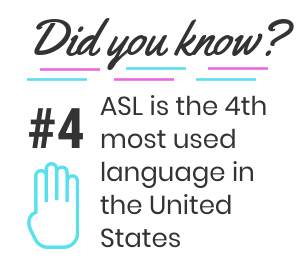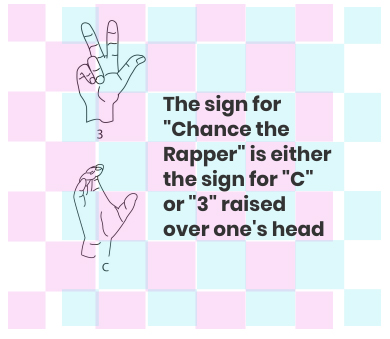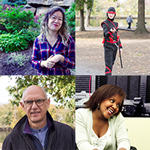Faces Behind the Screen: DEAFinitely Dope
RESOURCES
< < Return to all “Faces Behind the Screen” stories

Photo: Clayton Hauck
If you’ve been to any music festival in the last few years, you may have noticed someone else on stage who is not the performer but is still definitely performing.
Sign language interpreters are increasingly making a regular presence at live music events, making concerts and festivals more accessible to people in the audience who are deaf and hard of hearing.
Matt Maxey is one of those interpreters and happens to be hard of hearing himself. Matt is the founder of DEAFinitely Dope, an ASL interpreter and performance group helping deaf and hard-of-hearing fans enjoy live music. As it says on their Facebook page, the goal of DEAFinitely Dope is “to provide a platform where deaf people of all ages, as well as hearing people willing to take the plunge into the world of ASL, can unite under a brand that shows YOU’RE NOT ALONE.”
By making ASL more common at shows and festivals, Matt and the other interpreters in his company want to “inspire families, co-workers, classmates and more to learn sign language in anticipation of better communication one community at a time, while providing the resources in making the ASL learning experience more appealing and enjoyable!”
More recently, Matt and DEAFinitely Dope received the viral press treatment after being chosen to go on tour with Chance the Rapper as his personal ASL interpreter for live shows.
We Skyped with Matt to chat about his tour with Chance, DEAFinitely Dope, and how to bridge the musical gap between the deaf and hearing world.
What was it like being hand-selected by Chance the Rapper to be his personal concert interpreter?
MATT MAXEY: It was crazy. I was at Bonnaroo festival and I was doing D.R.A.M.’s set (Chance’s co-touring singer/rapper) and Chance was backstage.
So, after his set was over, Chance hit up the Access Department and was like, “Yo, the black guy interpreter you had, I want to meet him.” I’m like, yes, that’s me! I’m the only one here, that’s me!
He was like, “Come to Miami.” I was like, say no more. And that was it.
After we got that phone call, we met him after his show. And once we met, he started talking like, “Oh, I was watching what you were doing, and I like how into the music you got. You looked like you were vibing with the music. What are you guys doing for the next two weeks?”
And I’m like, uh, what you want us to do? [LAUGHS] He was like, “Come to Miami.” I was like, say no more. And that was it. It was all in a 15-20 minute talk, and the next thing I know, we’re going to Miami to work the tour. So, it was pretty crazy and pretty fast, all in a one-day time span.
Wow, life can happen really fast like that. What’s next?
MATT MAXEY: Tell me about it! [LAUGHS] This year we’re doing our own tour with DEAFinitely Dope. We’ll be going around, doing workshops, teaching an ASL music camp and basketball clinic and whatnot… so we pretty much have our own agenda.
We have worked with a few other rappers — Andy Mineo, the Christian rapper, we worked with him for Deaf Awareness Week — and we want to do more projects. We’re working on hosting a few shows in Kansas City, where we hope to bring a headliner in to help talk about how we can have more people come to shows, and how the interpretation could be allowed at the shows, and how they can coexist with each other.
It seems like you’re trying to really bring more interpreters into the world of music with your ASL camp.
MATT MAXEY: I’m not so much trying to bring in more interpreters, but trying to improve the quality of music.
The whole idea started from me watching interpreters. I was like, OK, I’m deaf, and I’m learning sign language… why can’t I understand the interpreter? If I pay for a show, and I go to the show, and I can’t even understand the interpreter, and then I can’t hear the rapper, there’s no point in it. But if I see other people who are also deaf or who have more knowledge of hip-hop, and I see how they interpret, and I enjoy it far more, then why not try to spread that around? Because I’m sure I’m not the only one who feels that way.
I feel like it’s easier to just identify as deaf because if I say hard of hearing, it gives me too much leeway. People think I hear more than I actually can.
You’ve almost got to make it like you’re performing it, too, because the way you act it out, the way you show me is how I understand and how other people understand, too.
It’s not only deaf people. Autistic people use sign language, too, so there are so many other people that could be learning, just from — I guess you could say, our way of interpreting music.
I feel like it impacts more people than just simply signing ASL, where it doesn’t really fit with the music sometimes. We want everybody to be able to enjoy the music.
The rock shows may be great. The jazz shows may be great. The country shows may be great. But the hip-hop shows are a work in progress, so let’s try to help them out.
Do you identify more as deaf or as hard of hearing?
MATT MAXEY: I actually identify more as deaf, even though I’m technically hard of hearing.
I feel like it’s easier to just identify as deaf because if I say hard of hearing, it gives me too much leeway. People think I hear more than I actually can. And instead, I feel like I have just as much love for sign language as I do for talking. So I’d rather just say I’m deaf, instead of hard of hearing and making it more confusing.
When did you start learning ASL?
MATT MAXEY: I grew up doing speech therapy, all the way from elementary school until my last year of high school. Gallaudet University was really the whole introduction to sign language and it took about three or four years before I really started to get the hang of it, because I was so used to talking in the hearing community.
More people will start to say, “Hey, this should be part of the show — I went to another show, and they had sign language interpreting. Why don’t y’all?”
I felt like pretty much all the ASL students. I had no idea of what to expect. But I was just really stubborn and stayed in the community and used music to help me learn. And here we are now.
Did you immediately gravitate to music as a way of practicing sign language?
MATT MAXEY: Yes, because I couldn’t talk with anybody! Everybody [at Gallaudet] was deaf, and I’m here talking, but nobody can hear me. And nobody knew what I was signing, so — who was my friend? Music. I just always listened to music — Jay Z, Kanye, DMX, everything.
So, you dropped out of Gallaudet and started delivering pizza for a while. Then what inspired you to start DEAFinitely Dope?
MATT MAXEY: As I was working, there was always difficulty because as a deaf person, it’s harder to get a job. And it’s harder to get a good job because there’s always communication problems.
There’s always the ADA law. You’re technically supposed to hire [non-discriminately] or provide equal access. But, if there was a manager and I couldn’t hear them, it was always just more frustrating for everybody involved.
So, when I started thinking about it, I was like, yo, there’s nothing in society for the Deaf culture. There’s nothing in the mainstream. There’s nothing people can wear and be like, “hey, I’m DEAFinitely Dope. I support the Deaf community. I support the Deaf culture.” There is nothing at all. So, the more I struggled, it woke me up to the thought that there was a need for something in the mainstream to spread awareness or at least start a discussion. Like, “OK, what is sign language? What is the Deaf community? Oh, they can sign music, too? Oh, they enjoy concerts. Oh, they play sports, OK,” and it just kind of opens the doors. Really, the idea just grew organically on its own.
How do we make music more accessible to people? How do we make ASL become more of a common thing at concerts?
MATT MAXEY: That’s part of our goal with DEAFinitely Dope. We’re trying to become the premiere go-to for concerts and festivals. If you host a show, you call on DEAFinitely Dope, and that way we can provide you with an interpreter that fits each genre. You get the best quality interpreting that we feel will meet our standards and your standards too.
I think a lot of it is really just spreading awareness. The more you show it on social media, the more you make the use of sign language interpreters more available, the more it’s exposed, the more it’s seen, the more awareness, the more change is actually going to happen.
Being deaf is cool. It’s just really what you make of it.
With festivals, concerts, and shows, if you look back 10 ago years to now it’s a lot of progress. There’s still a long way to go, but there’s been a lot more progress. Social media helps. Word of mouth helps. ASL is a growing language, that helps, too. There are more ASL programs in schools. That helps. So, it’s pretty much organic, and, honestly, the way it’s been going, the more you just talk about it, I think that’s the best way change can come.
More people will start to say, “Hey, this should be part of the show — I went to another show, and they had sign language interpreting. Why don’t y’all?” Those are the kinds of questions that start to come up, then it’s like, OK, we need to raise the bar. It’s a different ballgame now.
What’s one of the biggest misconceptions hearing people have about deaf and hard-of-hearing people?
MATT MAXEY: “Can you read my lips?” [LAUGHTER] That’s probably the biggest one.
But honestly, I think the biggest misconception — a lot of hearing people have made it clear to me that they always feel unsure about how to approach a deaf person.
Once you’ve got your mind set on something, I feel like it’s for a reason. Follow through and find out what that reason is.
Deaf people really just want to be a part of the hearing world, too. They want to communicate. So, they will figure it out by any means necessary. Whether it’s typing into a phone, whether it’s writing down, whether it’s teaching you how to sign the absolute basics, just to get the message across, they will put in the effort to communicate 95% of the time. And I feel like, with the hearing community, a lot of them are so scared to make that jump and actually just try to have a conversation instead of freezing up and stopping once you hear, “Oh, he’s deaf? She’s deaf? Oh, I’m sorry.” What are you sorry about? It’s the reality. We’re cool with it. You can be cool with it, too.
What’s the best thing about being deaf?
MATT MAXEY: Selective hearing. [LAUGHS] I sleep through the night like a baby. I don’t have to hear anything I don’t want to hear. I don’t even have to talk if I don’t want to. I can just be like, hey, I’m deaf. And they’d be like, oh, OK, I’ll write it down — thank you.
Being deaf is cool. It’s just really what you make of it. And at this point, I’m 29 now, so it’s like, nothing else you can do but laugh at it, to be honest. It’s a reality, it’s who I am, it’s a part of my identity. So, hey, sometimes I hear you — sometimes I don’t.
But never should you let that bring you down. Never should you let that stop you from doing what you want to do because even now with this DEAFinitely Dope journey, so many people have been telling me, “No. You can’t do it. Don’t do it. Do something else.”
Once you’ve got your mind set on something, I feel like it’s for a reason. Follow through and find out what that reason is. And that’s it.
We would like to extend a huge thank you to the Matt Maxey and DEAFinitely Dope for the opportunity to conduct this interview.
Check out deafinitelydope.org and keep an eye out for ASL interpreters at the next live show you attend!
Faces Behind the Screen is a storytelling project focusing on members of the Deaf and hard of hearing community.




